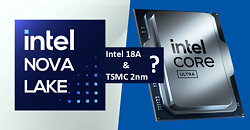Tuesday, April 22nd 2025

Intel's "Nova Lake" Processors Reportedly Slated for TSMC's 2nm Node
TSMC is pushing forward its plans to make 2 nm process chips in large quantities in the second half of the year, with major customer developments coming to light. After AMD placed its order, reports suggest Intel has also become one of TSMC's first 2 nm customers aiming to use this cutting-edge technology for its next-gen desktop processors. Intel, already a big TSMC customer for advanced processes sent out key compute tiles for its Core Ultra processors to TSMC using different processes like N3B, N5P, and N6. To be exact, these were Intel Core Ultra 200V "Lunar Lake" series laptop processors and Core Ultra 200S "Arrow Lake" series. While both companies didn't comment on the latest news, industry talk hints that they're cooperating on Intel's upcoming Nova Lake desktop processor set to launch next year (rumors suggest that it could be the Compute Tile). With the codename "NVL-S" Nova Lake combines two groups of eight high-performance "Coyote Cove" P-cores with 16 "Arctic Wolf" E-cores. It also includes four ultra-low-power LPE cores in a separate SoC tile. It is expected that Nova Lake-S will use LGA 1954, which has 1,954 active lands and might have more than 2,000 total pads when you count debug pins.
TSMC's work on 2 nm technology is moving forward as expected. The company uses first-generation nanochip transistor technology to boost performance and reduce power consumption across process nodes with big clients finishing designing silicon IPs and starting validation steps. AMD shared that its next EPYC "Venice" chip will be the first high-performance computing processor to use TSMC's 2 nm process. AMD validated it at TSMC's Arizona plant and is on track to launch it in 2026. Also, word has it that Apple's future iPhone 18 lineup will have its A20 chip made with the same TSMC 2 nm process.
Sources:
TrendForce, Economic Daily News
TSMC's work on 2 nm technology is moving forward as expected. The company uses first-generation nanochip transistor technology to boost performance and reduce power consumption across process nodes with big clients finishing designing silicon IPs and starting validation steps. AMD shared that its next EPYC "Venice" chip will be the first high-performance computing processor to use TSMC's 2 nm process. AMD validated it at TSMC's Arizona plant and is on track to launch it in 2026. Also, word has it that Apple's future iPhone 18 lineup will have its A20 chip made with the same TSMC 2 nm process.

14 Comments on Intel's "Nova Lake" Processors Reportedly Slated for TSMC's 2nm Node
1) Nova Lake is where 18A would make a difference with N2. Clearly, the clock speed of arrow lake is limited by N3, and N2 should be similar. We all know intel process is tuned to high speed.
2) it would have made more sense to make panther lake on N2, as clock speed is not the most important for mobile (but power consumption is).
3) anyway, we will know soon, as panther lake is 6 months away. They said it will be made on 18A. let see. If it is, it would be weird that nova lake use TSMC.
4) last, the yield claims by some south korean sources.... well we can be a bit skeptical (hello Samsung).
Also, yield without mentioning the size of the chip is meaningless: 20% of yield on full reticle die is ok. 20% yield on a small 100mm^2 die would be awful. Without mentioning that, the yield number is meaningless.
so yeah intel being 20% where tsmc is at 60% if it’s the same bench that would be quite horrible for intel
What is the new CEO waiting for to spin off the fabs?
Let s wait and see! Again, panther lake is not that far.
Condemning Intel over a rumor that isn't even specific about which tile is a little extreme. There were also rumors that Celestial will come to market this year and be built on 18A. Does that mean Intel's competitors all need to sign on to use 18A? And what about the rumors that Nova Lake uses Intel 14A?
Intel 4 came to market in December 2023. Despite Intel's hopes for a faster timeline, 18A is scheduled to come to market almost exactly 2 years later. That's a reasonable amount of time between the release of major nodes.
(And by some irony, that was a Chevrolet based on a Toyota and employing a Toyota engine in later versions.)